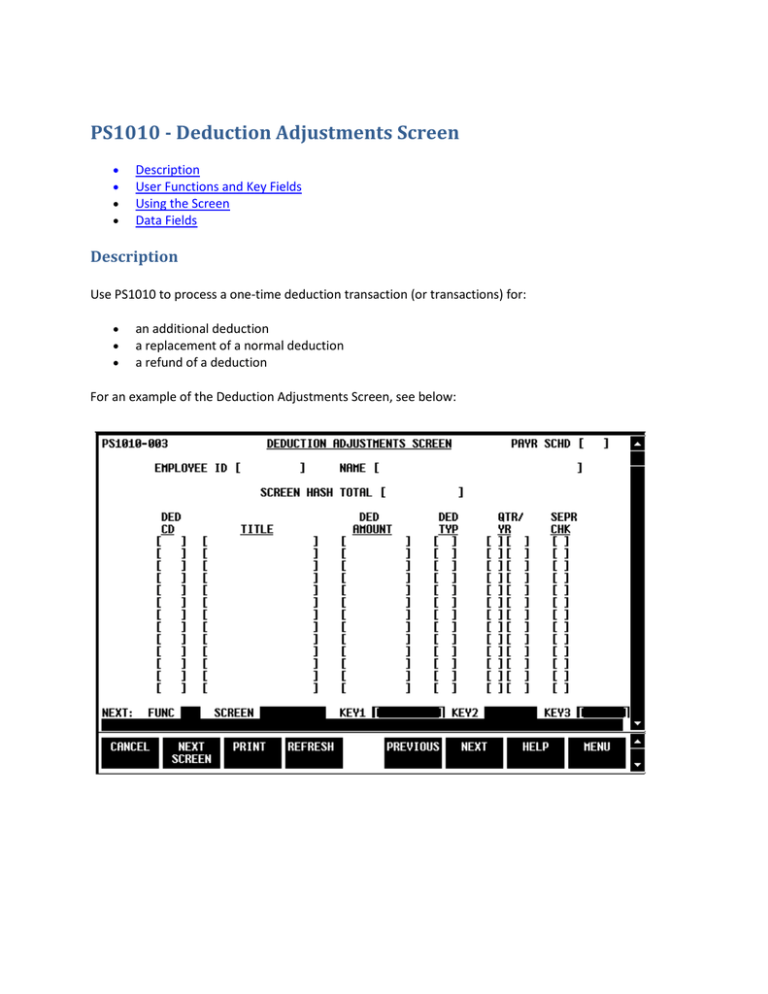PS1010 - Deduction Adjustments Screen Description
advertisement

PS1010 - Deduction Adjustments Screen • • • • Description User Functions and Key Fields Using the Screen Data Fields Description Use PS1010 to process a one-time deduction transaction (or transactions) for: • • • an additional deduction a replacement of a normal deduction a refund of a deduction For an example of the Deduction Adjustments Screen, see below: User Functions and Key Fields FUNC A (Add); C (Change); D (Delete); I (Inquire) KEY1 Enter an Employee ID KEY2 Leave blank KEY3 Enter a Payroll Schedule Using the Screen Use the Deductions Adjustments Screen to indicate that specific miscellaneous deductions should be taken from a separate check generated on the Retroactive Adjustments Screen (PS1003). PPMS matches the separate check indicator on the Retroactive Adjustments Screen with the separate check indicator on this screen. If a separate check is indicated, PPMS automatically calculates the mandatory deductions (such as taxes and retirement) for both the regular check and separate check, and takes the entire deduction from the regular check. However, you must add miscellaneous deductions on the Deduction Adjustments Screen so that the deductions will be taken from the separate check. You also use this screen to adjust a "reduction" refund. If the reduction affects current year balances, the refund will increase the taxable gross. On this screen, you take additional non-mandatory deductions from the increase. If the refund of a reduction affects the previous year balances, the previous year balances will be automatically corrected but the tax withheld will not be affected. Thus, a new W-2 should be submitted manually. Data Fields Payr Schd (Key3) Title Employee ID (Key1) Ded Amount Name (display only) Ded Typ Screen Hash Total Qtr/Yr (two fields) Ded Cd Sepr Chk Payroll Schedule (PAYR-SCHD) Definition Key3 field. A code identifying a specific payroll. Length 3 characters The first two characters identify the month of the accounting period (01-12). The third character identifies the schedule code. Values The third character is defined by the SBCTC-ITD on the Schedule Code Table (PS9042) as follows: A Semimonthly payroll schedule for the pay period of the 1st through the 15th of the month B Semimonthly payroll schedule for the pay period of the 16th through the last working day of the month H Hourly payroll schedule M Monthly payroll schedule S Supplemental schedule for fiscal year end Z Schedule for W-2 balance adjustments 1 First payroll schedule for new academic year Edits A payroll schedule must be initialized on the Payroll Schedule Initialization Screen (PS1000) before it can be used on the other Payroll Processing screens. On all Payroll Processing screens, the add, change, and delete functions cannot be performed for a payroll schedule if it has already been processed. The schedule code (third character of Payroll Schedule) must not be Z on the following screens: • • • • • • • • • Data sets Payroll Batch Control Screen (PS1001) Payroll Time Reporting Screen (PS1002) Retroactive Adjustments Screen (PS1003) Automatic Check Cancellation Screen (PS1005) Cancellation/Overpaymnt/Handdrawn Header Screen (PS1006) Cancellation/Overpaymnt/Handdrawn Distributions Screen (PS1007) Cancellation/Overpaymnt/Handdrawn Bonds Screen (PS1008) Deduction Adjustments Screen (PS1010) Payroll Expense Transfers Screen (PS1011) PAYR database: TBL5 database: PAYR-SCHD-D PAYR-SCHD-M DED-CAL-D Back to field list Employee ID (EMP-ID) Definition Entry required. A unique number that identifies an employee. This number is usually the employee's Social Security number. Length 9 digits Values College-entered on the Employee Status Screen (PS0001) or Student/Hourly Screen (PS0012) Edits On screens where the employee ID field is open, the employee ID must have been entered into the Employee database on the Employee Status Screen (PS0001) or the Student/Hourly Screen (PS0012). On the Employee Status Screen (PS0001) and the Student/Hourly Screen (PS0012), the employee ID field must not contain spaces. Data Sets Employee (EMP) database: DED-BAL-D (key) EMP-A (key) EMP-ADDR-D (key) EMP-BENE-D (key) EMP-BOND-D (key) EMP-DED-D (key) EMP-EDUC-D (key) EMP-HIST-D (key) EMP-JOB-D (one of 2 keys) EMP-M (key) EMP-NAME-D (one of 2 keys) EMP-YRQ-D (key) EMPLR-XREF-D (one of 2 keys) FAC-PLACE-D (key) LEAVE-DAY-D (key) LEAVE-XREF-D (one of 2 keys) Payroll (PAYR) database: COH-TRNS-M TIME-RPT-D Back to field list Employee Name (EMP-NAME) Definition Entry required. The full name of an employee. Length 30 characters Format Last, First Middle; Suffix A compound last name must have a hyphen between each part, for example SmithJones. There must be a comma between the last and first name, for example, SmithJones, Jane If the name includes a suffix, the middle name must be followed by a semi-colon, for example, Johnson, Robert Alan; Jr. Values Entered by college on the Employee Status Screen (PS0001). Can be changed on the Personal Information Screen (PS0004). Data Sets EMP database: EMP-M Back to field list Screen Hash Total (SCREEN-HASH-TOT) Definition The total of the entries in the Payroll Deduction Amount fields. Length 9 digits, including 2 decimal places Format 9999999.99 Values A minus sign (–) before the amount indicates that the hash total is a negative amount. Edits The total in the Screen Hash Total field must equal the total of the amounts in the Payroll Deduction fields. You can disable this edit using the FMS Message Code Table (ZX0010). For message number PS1010-0003, change the message severity to less than 4. Data Sets Not stored in the PAYR database Back to field list Deduction Code (DED-CD) Definition A code identifying a paycheck deduction. For example, the deduction code for Social Security is 020. Length 3 characters Values Defined on the Deduction Table (PS9002) by the SBCTC-ITD for deduction codes 001-399 and by each college for codes 400 and above. Data Sets EMP database: PAYR database: TBL5 database: DED-BAL-D EMP-DED-D COH-DED-D DED-ADJ-TRNS-D DED-BAL-ADJ-D DED-TBL-M HEALTH-TBL-M RETIRE-TBL-M Back to field list Deduction Title (DED-TITLE) Definition The descriptive title of a deduction, as printed on payroll checks and various payroll reports. Length 16 characters Values Defined on the Deduction Table (PS9002) by the SBCTC-ITD for deduction codes 001-399 and by each college for codes 400 and above. Data Sets EMP database: PAYR database: TBL5 database: Not stored in the EMP database Not stored in the PAYR database DED-TBL-M Back to field list Payroll Deduction Amount (PAYR-DED-AMT) Definition The amount taken from gross pay for a deduction. Length 7 digits, including 2 decimal places Format 99999.99 Edits An amount must be entered in this field unless the payroll deduction type is OR (one-time replacement) and the payroll deduction amount is zero. The total of the entries in the Payroll Deduction Amount fields must equal the screen hash total amount. Data Sets COH-BOND-D COH-DED-D DED-ADJ-TRNS-D Back to field list Payroll Deduction Type (PAYR-DED-TYP) Definition A code identifying a type of deduction as it relates to payroll. Length 2 characters Values Defined by SBCTC-ITD as follows: Blank Normal deduction/contribution O+ One-time deduction addition to vendor OP One-time deduction addition to prepayment account OR One-time deduction replacement to vendor PE Deduction refund from prepayment account to employee PP Prepayment entered to post a personal check from employee VE Deduction refund from vendor to employee/employer VP Deduction refund from vendor to prepayment account Edits A payroll deduction type of PP (prepayment) can be entered only if the deduction code on the Deduction Table (PS9002) does not have a deduction type of C (contribution) or a deduction class of T (tax). Additional Information A deduction refund will not update a declining balance. To update a declining balance, use the Miscellaneous Deduction Screen (PS0006). Data Sets COH-DED-D DED-ADJ-TRNS-D Back to field list Calendar Quarter (CAL-QTR) Definition A code identifying the calendar quarter to which the specified transactions apply. Length 1 character Values Defined by SBCTC-ITD as follows: 1 January to March 2 April to June 3 July to September 4 October to December Edits The combination of calendar quarter and calendar year must not be greater than the payroll check quarter and year. Data Sets COH-TRNS-M Back to field list Calendar Year (CAL-YR) Definition The last two digits of the calendar year for which the transactions apply. Length 2 digits Edits The combination of calendar quarter and calendar year must not be greater than the payroll check quarter and year. Data Sets COH-TRNS-M Back to field list Separate Check Code (SEPR-CHK-CD) Definition A code identifying the retroactive adjustments and/or deduction adjustments for which a separate payroll check should be produced. Length 1 character Values Defined by colleges Dependencies The Separate Check Code field occurs on: Retroactive Adjustments Screen (PS1003) Deductions Adjustments Screen (PS1010) If you assign a separate check code on PS1003 and want to withhold non-mandatory deductions from this check, you use PS1010. On PS1010, you must use the same separate check code that you used on PS1003. Note: Mandatory taxes will be calculated based on the gross amount of all checks processed and will be deducted from the employee's regular payroll check. Data Sets DED-ADJ-TRNS-D RETRO-ADJ-D


